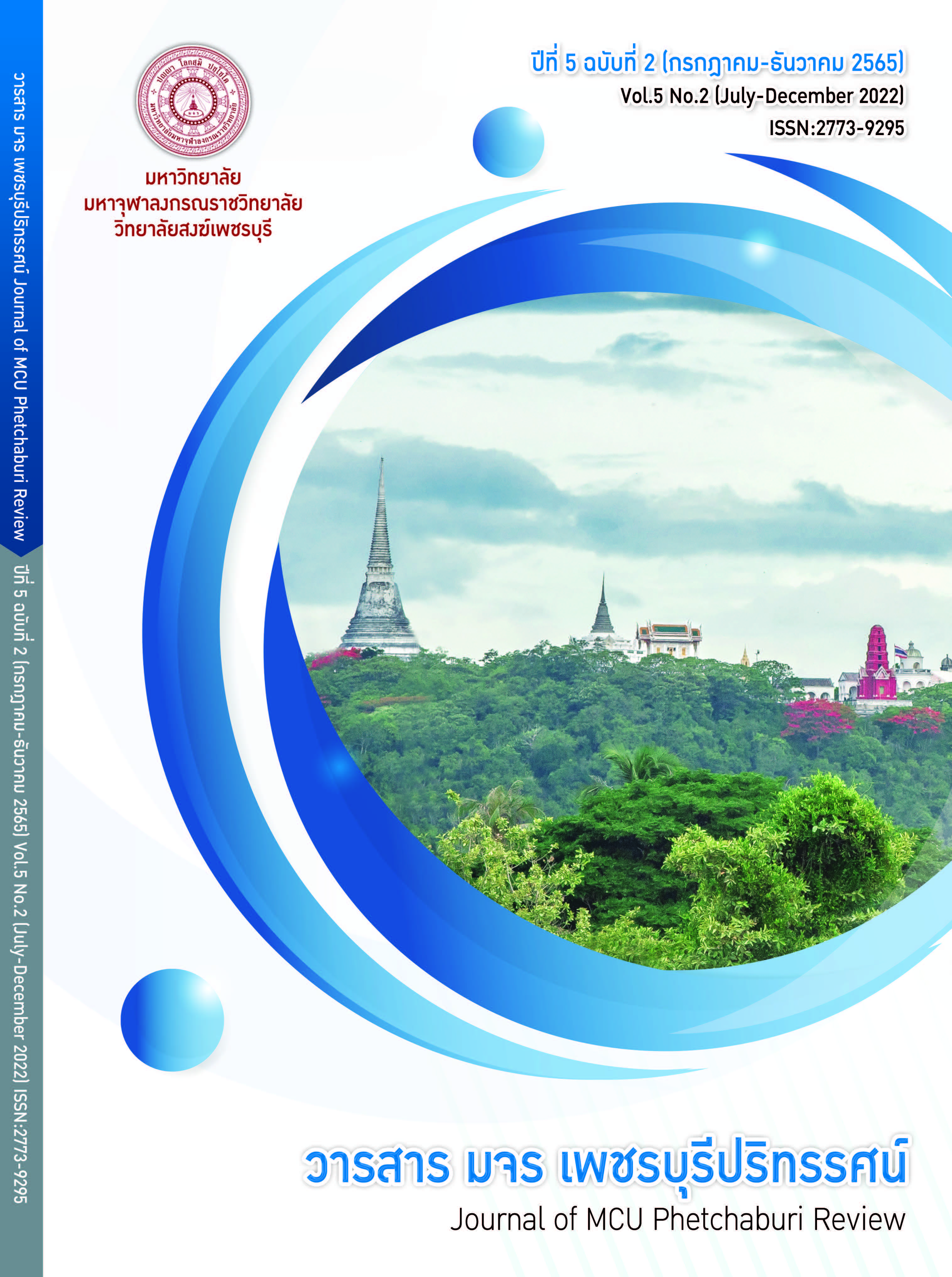DEVELOPMENT OF LEARNING ACHIEVEMENT IN BIOLOGY AND CRITICAL THINKING ABILITY BY USING 4MAT LEARNING MANAGEMENT AND MIND MAPPING TECHNIQUE IN MATHAYOMSUKSA 5 STUDENTS
Main Article Content
Abstract
Abstract
Critical thinking is a high-level thinking skill that is essential to life and important for work for now or even in the future. It is very important and necessary to cultivate the students which gives students the opportunity to practice critical thinking. Practice thinking rationally and being able to solve problems creatively. The researcher is therefore interested in conducting this research. The objectives are 1) To compare learning achievements in Biology subjects before and after using the 4MAT learning with mind mapping techniques of Mathayomsuksa 5 students. 2) To compare the critical thinking ability before and after using the 4MAT learning management method combined with the mind mapping technique of Mathayomsuksa 5 students. 3) To study the learning behavior of Mathayomsuksa 5 students receiving the 4MAT learning management method combined with the mind mapping technique. 4) To study the satisfaction of Mathayomsuksa 5 students toward the 4MAT learning management method combined with mind mapping techniques. The populations were Mathayomsuksa 5/1 students at PaDengvittaya School. Secondary Educational Service Area Office Phetchaburi. The first semester of 2022. The 44 students were selected by purposive sampling. The research tools were 1) A learning management plan using 4MAT learning management combined with a mind mapping technique. 2) A biology learning achievement test. The Reliability is 0.80. The Difficulty index is between 0.33-0.63. The Discriminant index is between 0.25-0.70. 3) Critical thinking ability test. The consistency index was 0.67-1.00. 4) Learning Behavior Observation Form 5) Satisfaction Questionnaire with 4MAT learning management combined with mind mapping technique. The statistics used were averaging. Standard deviation and T score.
The research results were as follows:
- Students’ biology learning achievement scores obtained after learning the lessons were higher than that of before with a statistically significant difference at .05.
- Students’ critical thinking skill scores obtained after learning the lessons were higher than that of before with a statistically significant difference at .05.
- The results of the analysis of learning behaviors of Mathayomsuksa 5 students who received the 4MAT learning management method together with the mind mapping technique revealed the behaviors that appeared in the early stages of the experiment. Some students still lack participation in answering questions or expressing opinions. Lack of knowledge and understanding about 4MAT learning management, As a result, the first period of development in this area is quite slow, Interest and willingness to learn have exchanged knowledge with others and jointly discussed the conclusions correctly.
- The analysis results of the satisfaction of Mathayomsuksa 5 students toward the 4MAT learning management with mind mapping techniques. When considering each side in order of average from the most to the least. Overall, it was found that No. 1 in learning management. Ranked the second highest level in terms of benefits that students receive was at the highest level; the 3rd was the instructor at a high level, and the 4th was the learning management media. At a high level
. The research findings the only way to manage 4MAT learning may make the Critical thinking ability of students not reach their full potential. Therefore, adding mind-mapping techniques to the learning process will help develop critical thinking abilities to be more effective.
Keywords : Critical thinking, 4MAT teaching model, mind mapping technique
Article Details

This work is licensed under a Creative Commons Attribution-NonCommercial-NoDerivatives 4.0 International License.
References
กนกรส ถมปลิก. (2555). ผลของการจัดการเรียนการสอนวิทยาศาสตร์ตามแนวทางของลาเซียร์ที่มีต่อความสามารถในการคิดอย่างมีวิจารณญาณและผลสัมฤทธิ์ทางการเรียนวิทยาศาสตร์ของนักเรียนมัธยมศึกษาตอนต้น. ใน (วิทยานิพนธ์มหาบัณฑิต). บัณฑิตวิทยาลัย จุฬาลงกรณ์มหาวิทยาลัย.
กระทรวงศึกษาธิการ. (2560). ตัวชี้วัดและหลักสูตรแกนกลาง กลุ่มสาระการเรียนรู้วิทยาศาสตร์ (ฉบับปรับปรุง พ.ศ.2560) ตามหลักสูตรแกนกลางการศึกษาขั้นพื้นฐาน พุทธศักราช 2551. กรุงเทพมหานคร: โรงพิมพ์ชุมนุมสหกรณ์การเกษตรแห่งประเทศไทย จำกัด.
กฤษณา นันขันตี. (2554). การเปรียบเทียบผลการเรียนด้วยการสอนแบบ 4MAT กับการสอนแบบปกติ ที่มีผลต่อผลสัมฤทธิ์ทางการเรียน เรื่อง เคมีอินทรีย์ ความสามารถในการคิดวิเคราะห์และความพึงพอใจต่อการเรียน ของนักเรียนชั้นมัธยมศึกษาปีที่ 6. ใน (วิทยานิพนธ์วิทยาศาสตรมหาบัณฑิต สาขาวิชาเคมีศึกษา). บัณฑิตวิทยาลัยมหาวิทยาลัยมหาสารคาม.
ชัยวัฒน์ สุทธิรัตน์. (2553). เทคนิคการใช้คำถามพัฒนาการคิด. กรุงเทพมหานคร: วีพริ้นท์.
บรรจง อมรชีวิน. (2556). การคิดอย่างมีวิจารณญาณ Critical thinking. กรุงเทพมหานคร: ภาพพิมพ์.
บุรินทร์ แก้วประพันธ์. (2555). ผลสัมฤทธิ์ทางการเรียนวิชาคณิตศาสตร์ เรื่อง ความน่าจะเป็นโดยใช้วิธีการจัดการเรียนรู้แบบ 4MAT สำหรับนักเรียนนักเรียนช่วงชั้นที่ 4. ใน (วิทยานิพนธ์ศึกษาศาสตรมหาบัณฑิต สาขาวิชาการสอนคณิตศาสตร์). บัณฑิตวิทยาลัย มหาวิทยาลัยเทคโนโลยีพระจอมเกล้าธนบุรี.
ประพันธ์ศิริ สุเสารัจ. (2556). การพัฒนาการคิด. (พิมพ์ครั้งที่ 5 ฉบับปรับปรุงใหม่). กรุงเทพมหานคร: 9119 เทคนิคพริ้นติ้ง.
ปิ่นแก้ว สระแก้ว. (2555). ผลการจัดกิจกรรมการเรียนรู้แบบ 4MAT เรื่อง ระบบประสาทและอวัยวะรับความรู้สึก รายวิชาชีววิทยา ชั้นมัธยมศึกษาปีที่ 5. ใน (การค้นคว้าอิสระศึกษาศาสตรมหาบัณฑิต สาขาหลักสูตรและการสอน). บัณฑิตวิทยาลัย มหาวิทยาลัยมหาสารคาม.
เรวัต แสงสุริยงค์. (2559). ยุคทองของนโยบายเทคโนโลยีสารสนเทศและการสื่อสารของประเทศไทย The Golden Age of Information and Communition Technology Policy in Thailand. วารสารวิชาการมนุษย์และสังคมศาสตร์ มหาวิทยาลัยบูรพา, 23(42), 1-42.
วรัญญา สินธุสำราญ. (2555). ผลการใช้เทคนิคการสร้างแผนที่ความคิดที่มีต่อการอ่านภาษาอังกฤษเพื่อความเข้าใจชองนักเรียนชั้นมัธยมศึกษาปีที่ 1. ใน (การศึกษาค้นคว้าด้วยตนเองหลักสูตรศิลปศาสตรมหาบัณฑิต). บัณฑิตวิทยาลัย มหาวิทยาลัยนเรศวร.
วิจารณ์ พานิช. (2555). วิถีสร้างการเรียนรู้เพื่อศิษย์ในศตวรรษที่ 21. กรุงเทพมหานคร: มูลนิธิสดศรีสฤษดิ์วงศ์.
วิมลรัตน์ สุนทรโรจน์. (2557). การออกแบบการจัดการเรียนรู้ตามแนวคิดแบบ Backward Design. พิมพ์ครั้งที่ 4. มหาสารคาม: กากะเยียสำนักพิมพ์.
สำนักงานคณะกรรมการพัฒนาการเศรษฐกิจและสังคมแห่งชาติ สำนักนายกรัฐมนตรี. ( 2565). แผนพัฒนาเศรษฐกิจและสังคมแห่งชาติ ฉบับที่สิบสอง พ.ศ. 2560-2564. เรียกใช้เมื่อ 4 มกราคม 2565 จาก http://www.nesdb.go.th/ewt_news.php?mid=6420
Bellanca, J. (2011). 21st Century Skills : Rethinking How Students Learn. New York: Solution Tree Press.
Buzan. (1991). Use both side of your brain. New York: Cambridge University.


